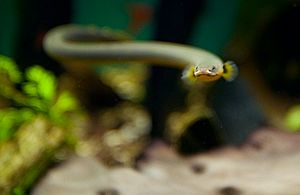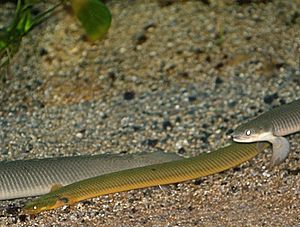Reedfish facts for kids
The reedfish, also called the ropefish or snakefish, is a unique freshwater fish. Its scientific name is Erpetoichthys calabaricus. It's the only type of fish in its group, called the genus Erpetoichthys. This interesting fish lives in West and Central Africa.
What makes the reedfish special is that it has both gills and a pair of lungs! This helps it breathe air from the surface, which means it can live in water that doesn't have much oxygen. Sadly, the reedfish is facing threats like habitat loss. This happens because of things like palm oil farms, other types of farming, cutting down forests, and cities growing bigger.
Quick facts for kids Reedfish |
|
|---|---|
 |
|
| Conservation status | |
| Scientific classification | |
| Genus: |
Erpetoichthys
|
| Species: |
calabaricus
|
| Synonyms | |
|
|
Contents
What Does a Reedfish Look Like?
The reedfish can grow up to about 37 cm (15 in) long. It has a long, thin body that looks a lot like an eel or a snake. It doesn't have the bottom fins that many fish have.
Its long fin on its back is made of several separate spines. Each spine supports one or more rays and a thin membrane. Young reedfish, called larvae, have clear external gills. These make them look a bit like baby salamanders.
The name Erpetoichthys comes from two Greek words. Erpeton means "creeping thing," and ichthys means "fish." This name perfectly describes how the reedfish moves!
Where Do Reedfish Live?
Reedfish prefer warm water that moves slowly or is still. This water can be slightly salty (called brackish) or fresh. The temperature usually ranges from 22–28 °C (72–82 °F).
You can find them in countries like Benin, Cameroon, and Nigeria. They might also live in the Republic of the Congo. Their home stretches from the Ogun River to the Chiloango River.
How Do Reedfish Live?
Reedfish are nocturnal, meaning they are most active at night. They eat annelid worms, small crustaceans like shrimp, and insects.
When they swim slowly, they use their side fins. But when they want to go fast, they move their whole body like an eel or snake. Reedfish are known to explore land if they get the chance. They can slither around like snakes and even find food on land!
Reedfish Reproduction and Life Cycle
Female reedfish lay small groups of eggs many times. They place these eggs between the male's anal fins, where the male fertilizes them. After fertilization, the male reedfish scatters the eggs among water plants. The eggs then stick to the plants and the bottom of the water.
The eggs hatch quickly, in about 70 hours. The tiny larvae stay attached to plants. They become independent and start eating after about 22 days, once they have used up the food from their egg's yolk sac.
Protecting Reedfish
The reedfish is currently listed as Near Threatened by the IUCN. This means it could become endangered in the future if we don't protect it.
In coastal parts of Central Africa, reedfish are losing their homes. This is mainly because of new oil palm farms. In West Africa, their habitat is also being damaged or lost. This happens when wetlands are drained for farming and city growth.
Reedfish as Pets
Some people keep reedfish in aquariums. All the reedfish in aquariums are caught from the wild. It's been very hard to breed them successfully in captivity. While spawning (laying eggs) and hatching have been seen, no baby reedfish have survived to become adults in aquariums.
Reedfish are curious, peaceful, and have unique personalities. Even though they are nocturnal, they sometimes come out during the day. Because they are so peaceful, other fish might try to "bully" them, especially when competing for food or space. Some reedfish like to stay near the water surface. Here, they are safe from other fish and might even let part of their body stick out of the water.
They can be a bit tricky to care for. They might jump out of tanks or get into water pumps, which can be dangerous for them. They are also sensitive to changes in water quality. Reedfish will often eat smaller fish if they get the chance. People sometimes feed them small goldfish or minnows instead of worms like bloodworms or nightcrawlers.
See also
 In Spanish: Bichir de Calabar para niños
In Spanish: Bichir de Calabar para niños



